BAGAN, Mandalay Region—Wandering along an unmarked dirt road in the freshly World Heritage-listed ancient city of Bagan in upper Myanmar almost always yields some sort of surprise. You may bump into a cluster of centuries-old red brick buildings, or a lone temple with unique architecture whose interior rewards visitors with the sight of murals dating back to the 12th century.
However, one path next to the Mingalar Zedi stupa in this tourist town leads to a different sort of encounter: a modern development mingled with ancient Buddhist temples—a jarring contrast to the historical and visual setting of the heritage monuments, as well as an act of sacrilege.
Welcome to the construction site of the 220-room Hilton Bagan Hotel, a joint project between the US multinational hospitality company and the local Eden Group Company Limited. The hotel itself appears nearly complete, but at the compound’s riverfront the construction of a dining hall is still in full swing. Several ancient monuments stand just a stone’s throw from the development sites. Making matters worse, both projects lie within the some 50-sq.-km “Property Zone”, an area “that has been demarcated as containing most of the cultural heritage attributes” by the Myanmar government and UNESCO.
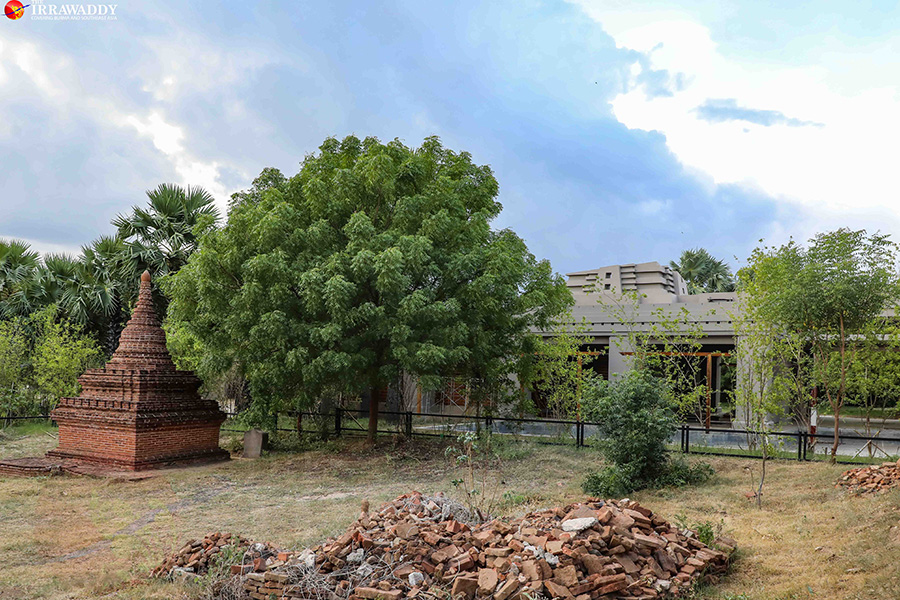
Apart from the Hilton Bagan, there are other development projects located within the zone, including The Nan Myint viewing tower located in the Aureum Palace Hotel; the Bagan Thande Hotel; the Bagan Hotel (River View); the Bagan Thiripyitsaya Sanctuary Resort; the Hotel@Tharabar Gate; and the Ayeyar Hotel. Many of their compounds encompass heritage monuments like temples or stupas.
Along with all the other factors putting pressure on the conservation of Bagan today, such as tourism and natural disasters, the presence of large-scale modern hotels in the property zone of this temple town of 3,595 Buddhist structures poses a major threat to the more than 1,000-year-old town’s integrity and authenticity, while somewhat undermining its recent inscription as a UNESCO World Heritage Site, experts said.
Even the International Council on Monuments and Sites (ICOMOS), a France-based international cultural heritage conservation team that recommended Bagan for inscription on UNESCO’s World Heritage List, says in its March evaluation report on the medieval town that the hotels are “intrusive and inconsistent with the historical and visual setting of the Buddhist monuments” while remarking that “hotel construction continues, both at new sites and through extensions to existing hotel facilities.”
U Sun Oo, the vice president of ICOMOS Myanmar, the country chapter of the council, told The Irrawaddy that the existence of the hotels, including ongoing projects, is having an impact on the temple town.
“The uniqueness of Bagan is not in pagodas or temples alone. You have to take into consideration their settings, and the archaeological landscape, as well. Nobody can deny those hotel constructions damage the setting,” he said.
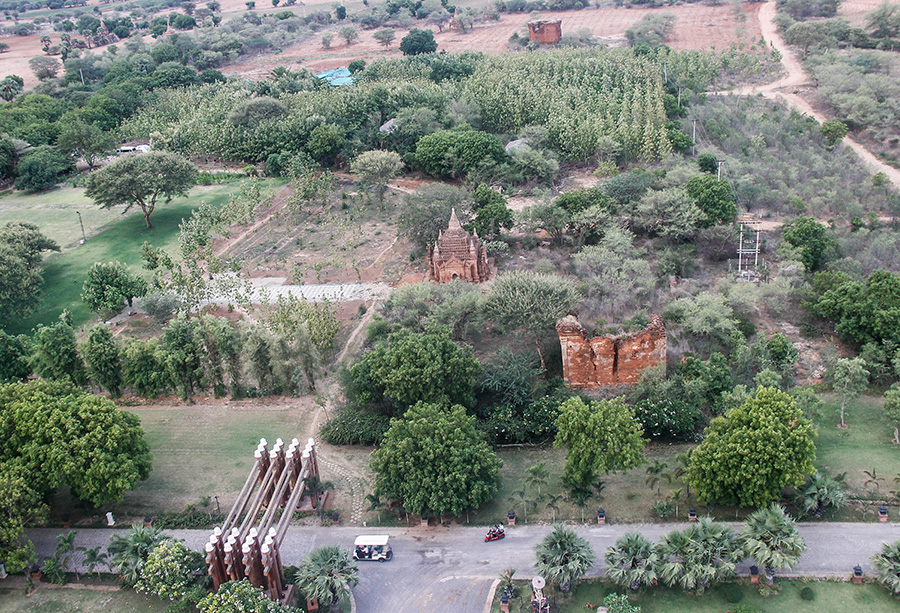
To tackle the problem, the Myanmar government submitted a management plan for Bagan to UNESCO in January 2018 as part of the nomination process. The plan includes strategies and guidelines to solve other issues like booming tourism, development, environmental problems and natural disasters. Calling the visitor accommodation issue “one of the greatest threats” to the Property Zone, the government commits in the management plan to assess all existing hotels and guesthouses within the zone to ensure that they do not impact the heritage site.
“All hotels and resorts located within the site, excluding those in towns that conform to the legal provisions, must be phased out by 2028. All further work on such resorts must stop. The hotels shall be entirely removed and the area shall be rehabilitated to become an
archaeological area again. Procedures need to be clarified with the respective owners,” the document says.
In reality, the hotel issue poses a huge challenge for the government. It needs to formulate longer-term solutions including assessing the properties’ impact on nearby heritage monuments in consultation with hotel owners and international conservation experts, according to U Aung Aung Kyaw, the director of the Department of Archaeology and National Museum (Bagan Branch).
“It won’t be an easy task,” he said.
Myanmar’s first dynasty
Sprawling along the bank of the Irrawaddy River in Mandalay Region, Bagan had its heyday in the 11th to the 13th centuries. Historian Thant Myint-U remarks in his book The River of Lost Footsteps that it was King Aniruddha of Bagan who unified the Irrawaddy valley under a single sovereign and created a kingdom that matched fairly closely the border of today’s Myanmar. The king took Thaton, a principality along the country’s southern coast on the Andaman Sea, and then fought his way all the way down to the Malay Peninsula, profiting from global business through long-distance traders from Ceylon and South India to the South China Sea.
Aniruddha is known not only for establishing the first Myanmar dynasty by unifying the country, but also for his promotion of Theravada Buddhism. As a man of passionate religious fervor, he built temples and pagodas in Bagan and elsewhere.

The historian notes in his book that Bagan was at the height of its glory by the 12th century, when buildings of sublime beauty rose up along the banks of the Irrawaddy. It had become a society of great creativity and energy, absorbing and transforming art and ideas from across the Indian subcontinent.
“The most impressive aspect of medieval Bagan was its openness to the outside world, its ability to draw in ideas and inspiration from across the region, and then remake them as part of a truly multicultural center,” he told The Irrawaddy.
More than 1,000 years after its heyday, despite being prone to earthquakes—a serious quake occurred there as recently as 2016—the onetime Buddhist kingdom is now a popular tourist town with a cluster of more than 3,000 temples of elegant masonry scattered over miles on the dusty, windswept plain of Bagan, which also incorporates living communities.
Among its other expressions of support for a UNESCO World Heritage Site inscription for Bagan, ICOMOS said that “Bagan is distinctive and outstanding” even relative to “the very rich expressions and traditions of Buddhist architecture and art found throughout Asia.” The temple town was inscribed on the list on July 6, becoming Myanmar’s second entry after the collective inscription of three Pyu cities in 2014.
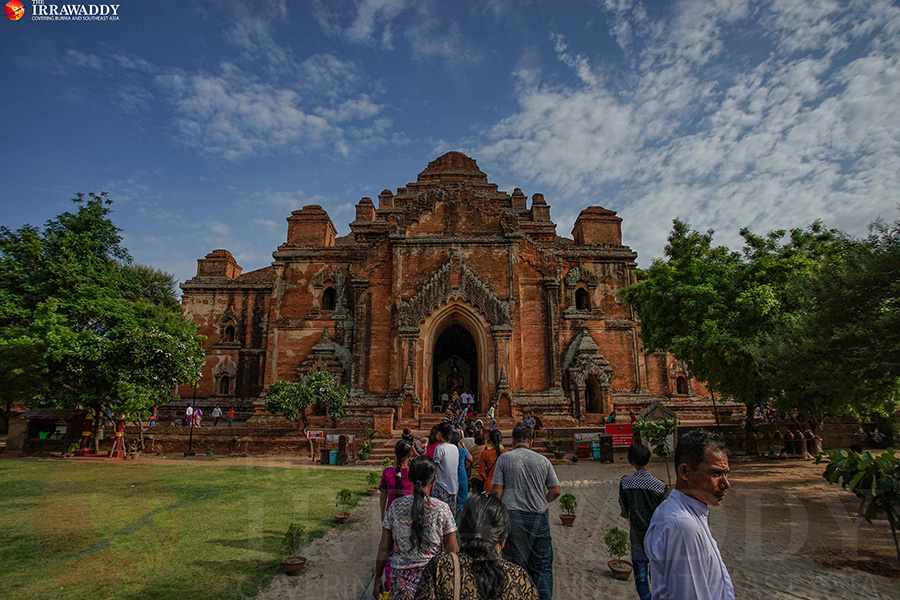
From the sublime to the ridiculous
Bagan was first nominated for a UNESCO listing in 1996 during the then military regime’s rule of the country, which lasted from 1988 to early 2011. Believing that it would help secure the nomination, the junta had in 1990 relocated hundreds of families living in Old Bagan, a property zone area inside the ancient city wall at the Tharapa Gate, reasoning that ancient monuments there should not be mingled with the community. It also started some renovation work at that time. But the nomination was eventually turned down for lack of a detailed management plan and provisions for infrastructure and tourism development.
The rejection seemed to hurt the pride of the then ruling generals. They took the conservation of the monuments into their own hands, and in the late 1990s accelerated the process, launching restoration work on a massive scale in Bagan. Their use of hypothetical reconstructions and inappropriate materials impacted the authenticity of the site, according to ICOMOS. The person in charge of the work was the country’s then spy master, General Khin Nyunt, who proclaimed himself “the restorer of Bagan.” Years later, in the early 2010s, he told reporters: “We can’t follow what UNESCO said. We have to conserve our [cultural heritage] on our own, whether they recognize Bagan or not.”
Luckily, the general’s restoration frenzy didn’t seem to have a serious impact. In its evaluation report for Bagan’s second nomination in 2018, ICOMOS said, “The nominated property retains its authenticity, through the presence of extensive original historic fabric, archaeological resources, murals and sculptures.”

Until its submission of the “Management Plan” to UNESCO in 2018, Bagan had virtually no comprehensive guidelines for conservation and protection of its heritage, especially to rein in developments like hotels.
Myanmar only enacted its first heritage protection law—The Protection and Preservation of Cultural Heritage Regions Law—in 1998, two years after its rejected nomination for the World Heritage List.
However, due to rampant corruption, cronyism and nepotism during the military government era, the law was nearly toothless when it came to protecting Bagan’s centuries-old heritage. Most of the hotels in question today and some now under construction were approved under the military regime and its successor, the U Thein Sein administration, the predecessor of today’s National League for Democracy (NLD)-led government. Shortly before leaving office in March 2016, the previous government approved 42 hotel construction projects in the property zone, according to current Religious Affairs and Culture Minister Thura U Aung Ko. The minister said in September 2016 that the current NLD government had to green-light 25 of the 42 hotels as they had already been built, while rejecting 17 that had not yet been started.
For Bagan natives, the hotels have become a source of pain. Seeing hotels mushroom in the places in which they used to reside, they doubtless can’t help but wonder whether their evictions simply made way for resorts owned by outsiders with deep pockets. Furthermore, when they were coping with strict government restrictions on building homes and running small businesses, lest they impact on the monuments, large-scale hotels rose up next to centuries-old temples.
“I feel we were sacrificed for the hotels,” said Ko Naing Naing Tun, an erstwhile resident of Old Bagan whose former home near Gawdaw Palin Temple is now in an extension area of the Bagan Hotel.
Currently, Bagan has 85 licensed hotels, according to the Ministry of Hotels and Tourism’s Bagan Branch. Nearly all of them are in the property zone, and some have ancient temples within their compounds, virtually off-limits to outside visitors. The Bagan Archaeological Department said the temples are open to visitors upon request.
Troubled legacy
U Aung Aung Kyaw, the director of the Department of Archaeology and National Museum (Bagan Branch), told The Irrawaddy that the hotels are a legacy of the previous government’s mistakes, saying, “We have inherited those mistakes and we are trying to solve them as best we can.”
“You can’t bulldoze the hotels previously allowed on the grounds that they are not in compliance with the current law. We need to formulate solutions to settle the problem,” he said, referring to the new Protection and Preservation of Cultural Heritage Zones Law. Enacted in February this year, the law prohibits any construction that may have a negative impact on nearby monuments.
As a solution, the director said, the hotels’ impact on heritage must be assessed first. Then the outcomes have to be reviewed by the government, UNESCO experts and hotel owners to negotiate to what extent the impact can be mitigated. When asked for the list of hotels still under construction, he declined to provide one, saying, “It’s not appropriate.”
Regarding the relocation of hotels in 2028, the director referred to his previous remark, adding, “That’s all I know so far; I can’t tell you more for the meantime.”
Despite the fact that the management plan commits the government to halt further work at resorts in the property zone, some projects were still under construction even shortly after the World Heritage Site inscription in early July. The riverfront dining hall in the Hilton Bagan Hotel compound, which houses 22 ancient temples, is just one example.
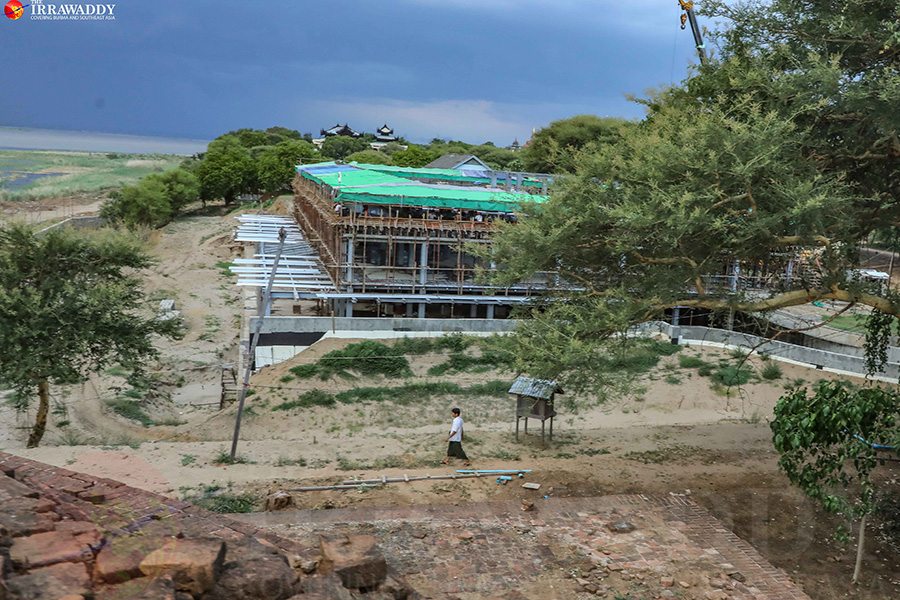
The Irrawaddy was able to observe the ongoing project during a visit to the monuments within the compound. During the tour, The Irrawaddy was escorted by at least three security guards employed by the hotel to make sure the visit was for religious purposes only. They repeatedly warned that no pictures should be taken of the nearly completed hotel or the ongoing waterfront project, insisting that “this is a project area.” The Irrawaddy received a stern request to delete all photos taken of the waterfront project. When asked about the project, the guards replied simply that it was “a construction site.”
Apart from the ongoing construction near the river, the Buddhist temples in the compound have raised experts’ concerns due to their proximity to the hotel. In its 2015 report to the Culture Ministry, the Association of Myanmar Architects, which was involved in drafting the master plan for Bagan’s property zone, warned that some of the hotel properties are in “very close range of the temples”, breaching the official limit at the time.
The report viewed by The Irrawaddy states that “some [hotel structures] are as close as 12 feet to the ancient monuments” and recommends that “all buildings have to be relocated at least 90 feet” from the heritage sites as required under Bagan Heritage Conservation regulations announced in 1990.
However, during a recent visit, The Irrawaddy observed that barely any of the suggested changes had been made. At the entrance, for example, several nearly finished one-story buildings stand a stone’s throw from centuries-old temples.
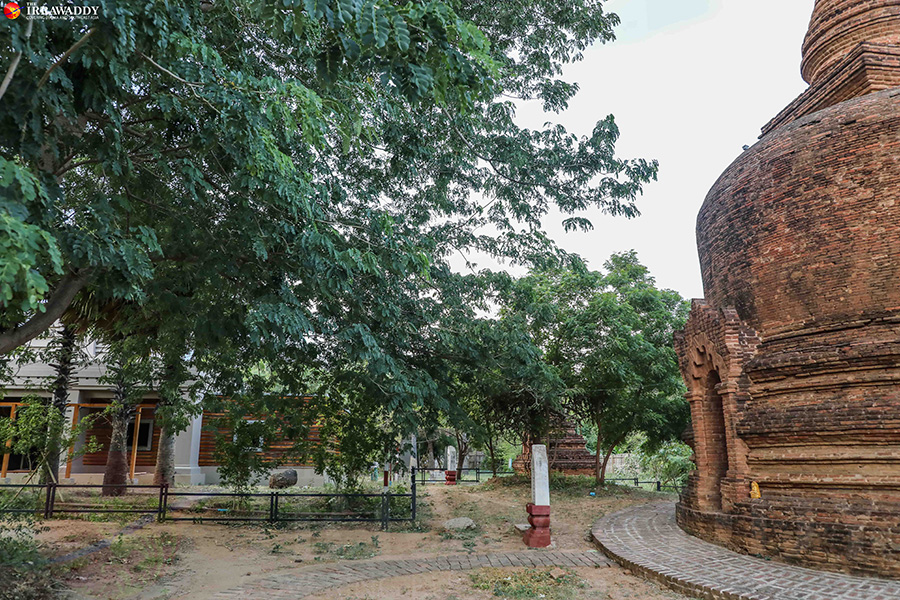
U Chit Khine, chairman of the Eden Group, the local partner of Hilton Bagan, told The Irrawaddy that the buildings are for a reception hall and the company is waiting for the government’s instructions on whether to keep them or demolish them.
He explained that the hotel was permitted by the military government because it was located in the then Hotel Zone, and that construction started under its successor U Thein Sein’s administration. (The zone was later scrapped and became an extension of the Property Zone.) The chairman said the waterfront dining hall’s construction is in compliance with the current distance limit guidelines. The 2014 regulation requires any development to be at least 120 feet from a monument. (But as the riverfront area is in the property zone, the waterfront project still falls within the area that is off-limits to development.)
Asked if he would follow the government’s relocation proposal in 2028 as stated in the management plan, U Chit Khine said his intention was to go ahead with the hotel, as the project required considerable investment. However, he continued, if every hotel in Bagan is obliged to comply, he would do so.
“So far, I haven’t received any instructions from the government on what to do with the hotel. We are in limbo,” the chairman said.
To the south of Hilton Bagan, in the Property Zone around the riverfront not far from Saytanar Gyi Pagoda, stands the Sanda Hotel developed by Sanda Co. Ltd., a company whose managing director is Daw Khin Sanda Win, the wife Andrew Patrick, a former British ambassador to Myanmar.
Obscured by vegetation, the project is out of sight from the road. But at a closer distance, The Irrawaddy saw some buildings through the foliage, as well as some structures rising above the nearby trees.

Asked to comment by The Irrawaddy, company manager Daw Thae Ma Ma Nyein replied via email that the 14-room hotel is now complete and the decoration process under way. She said the hotel was approved during U Thein Sein’s administration and green-lighted for construction under the NLD government in 2017
“We are confident it will not impact on the heritage of Bagan,” Daw Thae Ma Ma Nyein says in the email, adding that the company looks forward to working with the government on preserving the World Heritage site.
The Irrawaddy has learned that the NLD government allowed the construction at the same time as it was preparing to submit the Bagan nomination dossier to the World Heritage Committee. When asked about the coincidence, U Aung Aung Kyaw, the director of the Department of Archaeology and National Museum (Bagan Branch), said only: “We let it go ahead, as it had been approved previously. We have not permitted any projects since then.”
Strings attached
Bagan’s recent inscription on UNESCO’s World Heritage List is conditional. The government must fulfill the commitments it made in its management plan and comply with 20 additional recommendations, including those relating to hotels, made by ICOMOS.
In addition to the removal of intrusive hotels and tourism facilities, and taking account of the need for a phased approach and longer-term strategy for hotels in Bagan, ICOMOS has urged the government to work with it and UNESCO to prepare a hotel strategy to create hotel zones and make any necessary changes to existing facilities.
“All new developments should be subject to heritage impact assessment, and the establishment of zones where hotel developments can occur should be accompanied by regulations concerning building heights and other site and design issues, and be integrated into the regional Tourism Strategy,” its recommendation says.
The Myanmar government is required to report on its implementation of the recommendations to the World Heritage Center by December 2021. Any failure to take the corrective actions required under the commitments and recommendations would endanger the inscription, experts warned.
“All the ongoing projects should be halted for heritage impact assessment. If not, Bagan would be endangered, as you can’t do anything that could harm heritage in the property zone,” said Daw Ohmmar Myo, a former UNESCO coordinator now involved in heritage management of the temple town.

Historian Thant Myint-U believes it is incredibly important that what remains is now properly protected, and that investments are made in research and scholarship, if tourism is to be part of Bagan’s future.
“But it should be carefully managed; a sustainable tourism strategy that creates well-paying jobs and maximizes benefits for local people, rather than short-sighted policies that seek only to maximize profits for a handful of hoteliers and investors.”
However, given the ongoing projects along the Irrawaddy River and in the Property Zone, it seems there is no quick fix in sight.
For all his acknowledgment that heritage impact assessment is required in the first place, even U Aung Aung Kyaw, the director of the Department of Archaeology and National Museum (Bagan Branch), has no idea when such a heritage impact assessment could be launched.
“It needs further discussions. So, it’s difficult to say now when we could implement it.”

















